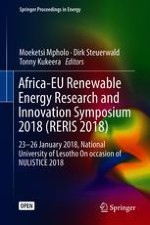This open access book presents the proceedings of the 2nd Africa-EU Renewable Energy Research and Innovation Symposium (RERIS 18), held in Maseru, Lesotho in January 2018. The symposium aimed to foster research cooperation on renewable energy between Africa and Europe – in academia, as well as the private and public sectors.
Addressing thematic areas such as
• Grid-connected renewable energy;
• Decentralised renewable and household energy solutions;
• Energy socioeconomics; and
• Promotion of energy research, innovation, education and entrepreneurship,
the book brings together contributions from academics and practitioners from the EU and Africa to enable mutual learning and knowledge transfer – a key factor in boosting sustainable development in the African renewable energy market. It also plays a significant role in promoting African renewable energy research, which helps to secure energy supply in both rural and urban areas and to increase generation capacities and energy system resilience. This book is an invaluable resource for academics and professionals across the renewable energy spectrum.
